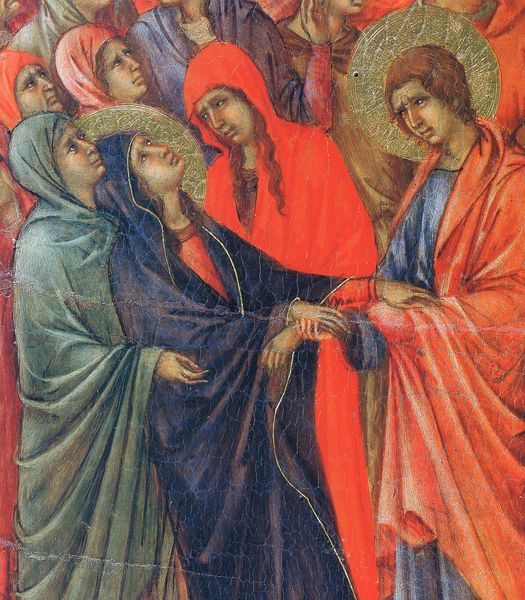
tempera, painting, oil-paint
#
medieval
#
tempera
#
painting
#
oil-paint
#
sienese-school
#
painted
#
figuration
#
oil painting
#
christianity
#
painting art
#
history-painting
#
italian-renaissance
#
virgin-mary
#
christ
Copyright: Public domain
Editor: We're looking at "The Position of Mary in the Tomb (Fragment)" by Duccio, from 1311. It appears to be a tempera and oil-paint painting, and it strikes me as quite somber. There's a real weight to the figures gathered around what I presume is Mary’s tomb. How do you interpret this work, especially given its historical context? Curator: What immediately grabs my attention is the collective grief, but I’m equally drawn to considering this fragment through a feminist lens. Mary's agency, even in death, becomes a focal point. Think about the power dynamics at play during the early 14th century – how often were women, especially mothers, centered in such a powerful narrative? Editor: That's an interesting point. I hadn't considered the rarity of female-centered narratives at the time. Does the specific way Duccio portrays Mary – her posture, her face – contribute to this sense of agency? Curator: Absolutely. Notice how the figures surrounding her aren't actively lamenting with grand gestures, but rather there's a subdued respect, almost a reverence. Her stillness contrasts their movements. This moment signifies not just mourning but also a transition in power, symbolically acknowledging the feminine divine. What might the choice of colors signify in portraying such social constructs and the themes they address? Editor: The muted colors, perhaps reflecting the solemnity of the occasion, but also, potentially, hinting at the limited roles women were often assigned? The gold background feels… conflicting. Simultaneously sacred but also maybe trapping? Curator: Exactly! And consider, too, how the narrative surrounding Mary often positioned her in relation to male figures – Christ, Joseph, God. Here, we see a community focused solely on her, if even just for this singular painted moment in time, and then think about all the women throughout history who haven't been granted this recognition. Editor: I’m definitely seeing new dimensions to the artwork. Thinking about this image through a lens of gender and power is truly impactful. Curator: It really challenges us to confront historical biases and celebrate the voices, or rather, the images of people who were often overlooked.
Comments
No comments
Be the first to comment and join the conversation on the ultimate creative platform.













